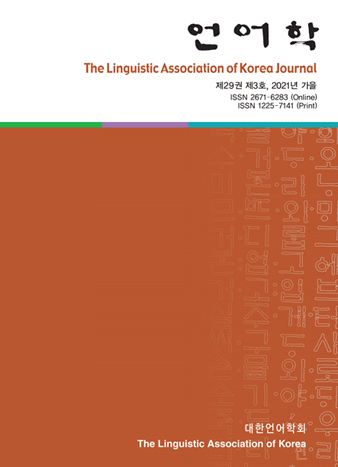대한언어학회 전자저널
29권 3호 (2021년 9월)
- 영어 관계사절 습득 과정에서 한국 L2 학습자들의 공백에 대한 민감성 연구
-
조우영
Pages : 67-84
Abstract
Cho, Wooyoung. (2021). Korean L2 learners' sensitivity to gaps in acquisition process of English relative clauses. The Linguistic Association of Korea Journal, 29(3), 67-84. The purpose of this paper is twofold: (1) to explore the Korean L2 learners' acquisition order of 9 types of English relative clauses, classified by the grammatical role of both the head (nominal that the relative clause modifies) and the gap within the relative clauses; and (2) to examine the correlation between Korean L2 learners' comprehension and the distribution of relative clauses in English textbooks. Eighty Korean middle school students participated in the experiment. The major findings of this experimental study are as follows: First, the order of comprehension is SO> OO > OS > SS, which is not similar to those shown in the previous studies. Second, the embedded depth of subject gaps as well as word order of L1 made Korean L2 learners difficult to comprehend English relative clauses. Third, both the distribution and the frequency of relative clauses in English textbooks seem not to reflect the comprehension pattern of Korean L2 learners properly.
Keywords
# 주어 공백(subject gaps) # 목적어 공백(object gaps) # 구조적 거리(structural distance) # 내포 깊이(the depth of embeddeness) # 어순 (word order)
References
- Cho, S. (1999). The acquisition of relative clauses: Experimental studies on Korean. Unpublished doctoral dissertation, University of Hawaii at Manoa.
- Clancy, P., Lee, H., & Zoh, M. (1986). Processing strategies in the acquisition of relative clauses: Universal Principles and language specific realization. Cognition, 24, 225-262.
- de Villiers, J., Trager-Flusberg, H., Hakuda, K., & Cohen, M. (1979). Children's comprehension of relative clauses. Journal of Psycholinguistic Research, 8(5), 499-518.
- O'Grady, W. (1997). Syntactic development. Chicago: University of Chicago Press.
- O'Grady, W., & Archivald, J. (2004). Contemporary linguistic analysis: An Introduction (5th ed.). Toronto: Pearson Longman.
- O'Grady, W., Lee, M., & Choo, M. 2003. A subject-object asymmetry in the acquisition of relative clauses in Korean as a second language. Studies in Second Language Acquisition, 25(3), 433-448.
- Sheldon, A. (1974). The role of parallel function in the acquisition of relative clauses in English. Journal of Verbal Learning and Verbal Behavior, 13, 272-281.
- Slobin, D. (1973). Cognitive prerequisites for the development of grammar. In C. Ferguson & D. Slobin (Eds.), Studies of child language development (pp. 175-208). New York: Holt, Rinehart and Winston.
- Tavakolian, S. (1981). The conjoined-clause analysis of relative clauses. In S. Tavakolian (Ed.), Language acquisition and linguistic theory (pp. 167-187). Cambridge: The MIT Press.
- Jung, C.-Y. et. al. (2021). Middle school English: 2nd year textbook. Seoul: Cheonjae-kyoyuk.
- Jung, C.-Y. et. al. (2021). Middle school English: 3rd year textbook. Seoul: Cheonjae-kyoyuk.
Secondary Materials:
